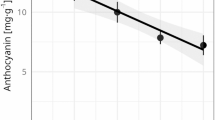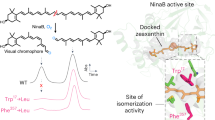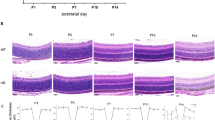Abstract
The perception of photoperiod by insects and mites requires a photoreceptor which is probably located in the brain1–5. Recently, the functional involvement of carotenoids in the photoperiodic reaction of two mite species has been demonstrated using techniques based on mutant studies and nutritional studies respectively6–8. In dietary studies with insects, evidence for the participation of carotenoids in the photoperiodic induction of diapause has been found in one moth species9, whereas carotenoid deprivation has no effect in another moth10 and a butterfly11. Here we show that vitamin A as well as carotenoids with provitamin A function, but not vitamin A acid, restores the photoperiodic reaction in an eyeless predacious mite which has lost all sensitivity to the photoperiod after having been reared for more than one generation on pollen of broad bean, which constitutes a completely carotenoid-free diet. This study suggests that a rhodopsin-like pigment functions as the photoreceptor for the photoperiodic induction of diapause in these mites.
This is a preview of subscription content, access via your institution
Access options
Subscribe to this journal
Receive 51 print issues and online access
$199.00 per year
only $3.90 per issue
Buy this article
- Purchase on SpringerLink
- Instant access to full article PDF
Prices may be subject to local taxes which are calculated during checkout
Similar content being viewed by others
References
Lees, A. D. J. exp. Biol. 41, 119–133 (1964).
Williams, C. M. & Adkisson, P. L. Biol. Bull. mar. biol. Lab., Woods Hole 127, 511–525 (1964).
Claret, J. Ann. Endocr. 27, 311–320 (1966).
Seugé, J. & Veith, K. J. Insect Physiol. 22, 1229–1235 (1976).
Steel, C. G. H. & Lees, A. D. J. exp. Biol. 67, 117–135 (1977).
Veerman, A. & Helle, W. Nature 275, 234 (1978).
Veerman, A. Physiol. Ent. 5, 291–300 (1980).
Van Zon, A. Q., Overmeer, W. P. J. & Veerman, A. Science 213, 1131–1133 (1981).
Takeda, M. thesis, Univ. Missouri (1978).
Shimizu, I. J. Insect Physiol. 28, 841–846 (1982).
Rothschild, M. in Biochemical Aspects of Plant and Animal Coevolution (ed. Harborne, J. B.) 259–276 (Academic, New York, 1978).
Overmeer, W. P. J. & Van Zon, A. Q. Ent. exp. appl. 33, 27–30 (1983).
Wolken, J. J. Photoprocesses, Photoreceptors and Evolution (Academic, New York, 1975).
Pitt, G. A. J. in Carotenoids (ed. Isler, O.) 717–742 (Birkhäuser, Basel, 1971).
Feltwell, J. in Biochemical Aspects of Plant and Animal Coevolution (ed. Harborne, J. B.) 277–307 (Academic, New York, 1978).
Veerman, A. Comp. Biochem. Physiol. 36, 749–763 (1970).
Dadd, R. H. A. Rev. Ent. 18, 381–420 (1973).
White, R. H. Adv. Insect Physiol. 13, 35–67 (1978).
Truman, J. W. Photochem. Photobiol. 23, 215–225 (1976).
Zimmerman, W. F. & Goldsmith, T. H. Science 171, 1167–1169 (1971).
Klemm, E. & Ninnemann, H. Photochem. Photobiol. 24, 369–371 (1976).
Ninnemann, H. in Photochem. Photobiol. Rev.. Vol. 4 (ed. Smith, K. C.) 207–266 (Plenum, New York, 1979).
Vaz Nunes, M. & Veerman, A. J. Insect Physiol. 28, 1041–1053 (1982).
De Fabo, E. in The Blue Light Syndrome (ed. Senger, H.) 187–197 (Springer, Berlin, 1980).
Lees, A. D. J. Insect Physiol. 27, 761–771 (1981).
Overmeer, W. P. J., Doodeman, M. & Van Zon, A. Q. Z. angew. Ent. 93, 1–11 (1982).
Author information
Authors and Affiliations
Rights and permissions
About this article
Cite this article
Veerman, A., Overmeer, W., van Zon, A. et al. Vitamin A is essential for photoperiodic induction of diapause in an eyeless mite. Nature 302, 248–249 (1983). https://doi.org/10.1038/302248a0
Received:
Accepted:
Issue date:
DOI: https://doi.org/10.1038/302248a0
This article is cited by
-
Physiological and molecular mechanisms underlying photoperiodism in the spider mite: comparisons with insects
Journal of Comparative Physiology B (2016)
-
Both the anterior and posterior eyes function as photoreceptors for photoperiodic termination of diapause in the two-spotted spider mite
Journal of Comparative Physiology A (2014)
-
Vulnerability and behavioral response to ultraviolet radiation in the components of a foliar mite prey–predator system
Naturwissenschaften (2012)
-
Diapause in phytoseiid mites: a review
Experimental & Applied Acarology (1992)
-
Diapause induction in the thrips predatorAmblyseius cucumeris [Acarina: phytoseiidae] under greenhouse conditions
Entomophaga (1991)



